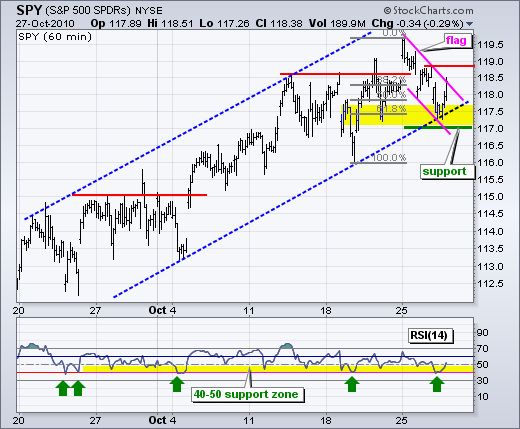There is no change on the daily chart. Even though the advance has grown laborious, SPY remains in an uptrend. The surge above 114 on September 20th marked the easy part of the advance. Since this surge, SPY has worked its way higher within a rising price channel. All kinds of indecisive and bearish candlesticks formed, but these were never confirmed with a downside move. A break below channel support at 117 would argue for a pullback towards broken resistance around 112. CCI remains in its bull zone and has yet to break 50 to signal weakness in momentum.
On the 60-minute chart, SPY bounced of channel support and RSI bounced of 40 to keep the uptrend alive. The decline over the last three days looks like a falling flag, which is a bullish corrective pattern. In fact, also notice that the falling flag retraced around 62% of last week's advance. SPY dipped below 117.5 yesterday afternoon, but a late rally pushed the ETF above 118 by the close. Further strength above flag resistance would signal yet another continuation higher. RSI bounced off 40 for at least the fifth time in six weeks. This support level has certainly earned its keep. A convincing trend reversal will not occur until RSI breaks 40 AND SPY breaks below 117.

Key Economic Reports:
Oct 28 - 08:30 - Jobless Claims
Oct 28 - 16:30 – Fed Balance Sheet
Oct 29 - 08:30 - GDP
Oct 29 - 09:45 - Chicago PMI
Oct 29 - 09:55 - Michigan Sentiment
Charts: Tuesday and Thursday in separate post.
-----------------------------------------------------------------------------
This commentary and charts-of-interest are designed to stimulate thinking. This analysis is not a recommendation to buy, sell, hold or sell short any security (stock ETF or otherwise). We all need to think for ourselves when it comes to trading our own accounts. First, it is the only way to really learn. Second, we are the only ones responsible for our decisions. Think of these charts as food for further analysis. Before making a trade, it is important to have a plan. Plan the trade and trade the plan. Among other things, this includes setting a trigger level, a target area and a stop-loss level. It is also important to plan for three possible price movements: advance, decline or sideways. Have a plan for all three scenarios BEFORE making the trade. Consider possible holding times. And finally, look at overall market conditions and sector/industry performance.

About the author:
Arthur Hill, CMT, is the Chief Technical Strategist at TrendInvestorPro.com. Focusing predominantly on US equities and ETFs, his systematic approach of identifying trend, finding signals within the trend, and setting key price levels has made him an esteemed market technician. Arthur has written articles for numerous financial publications including Barrons and Stocks & Commodities Magazine. In addition to his Chartered Market Technician (CMT) designation, he holds an MBA from the Cass Business School at City University in London.
Learn More
